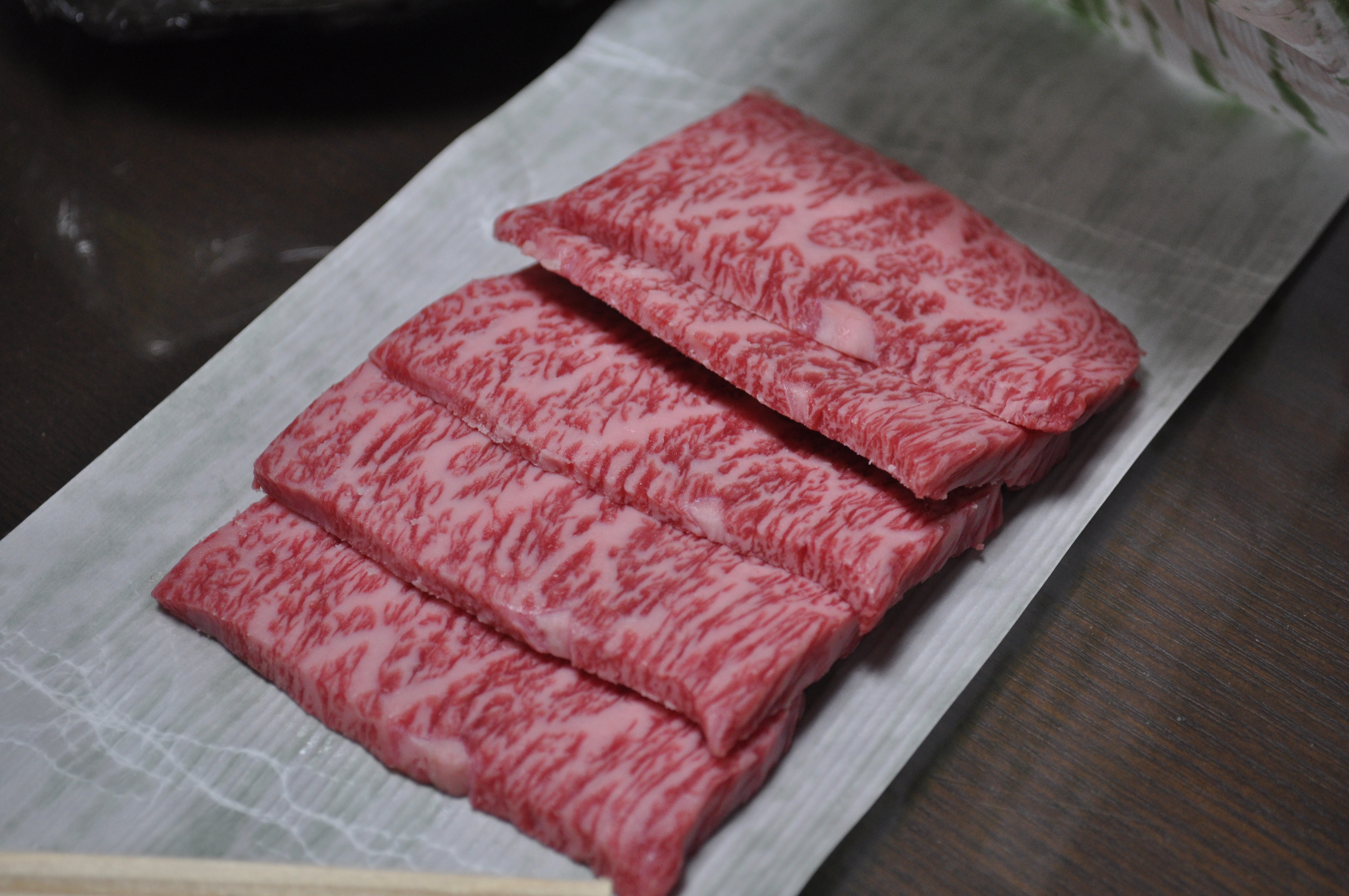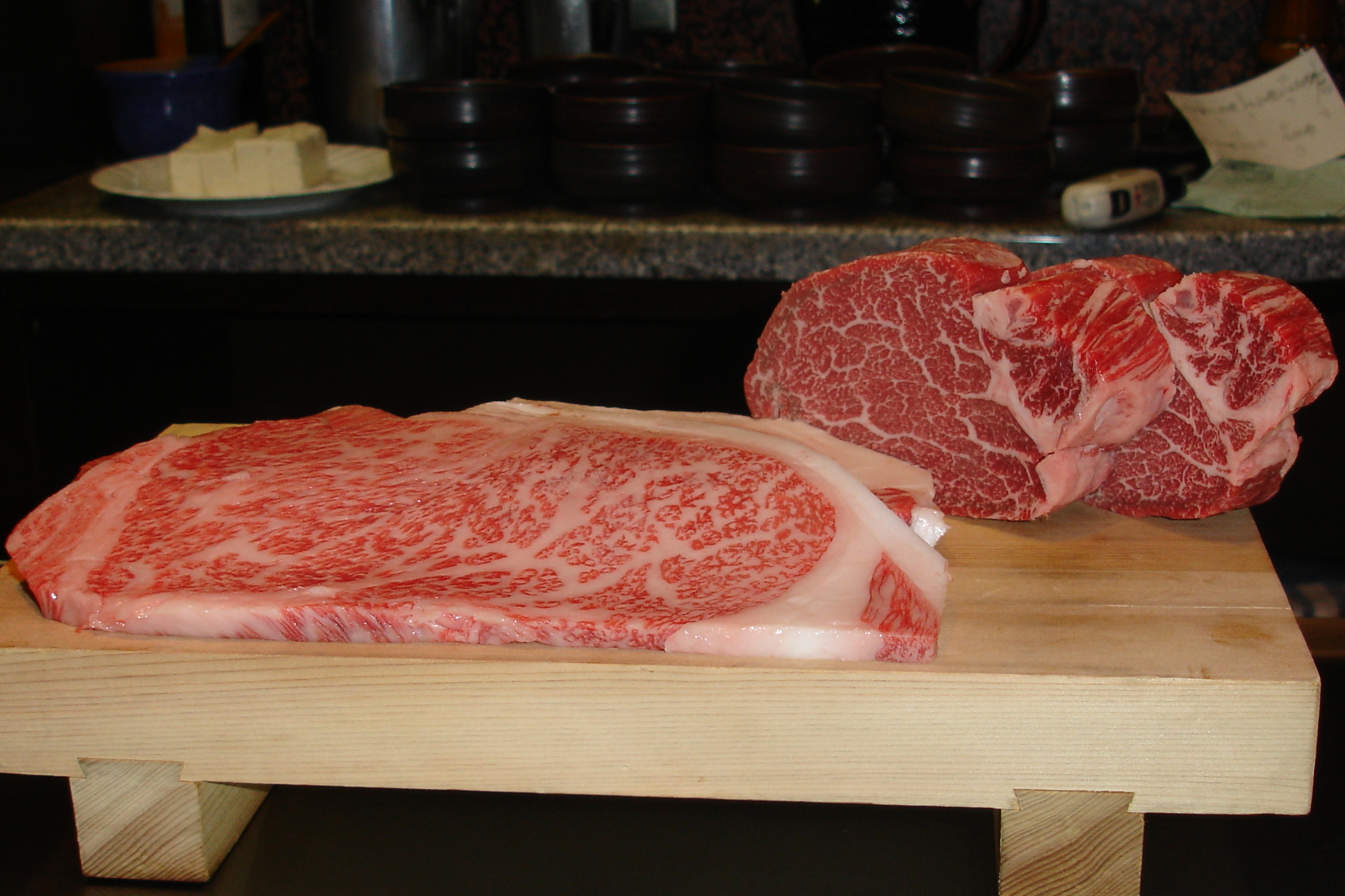|
Matsuzaka Beef
is the meat of Japanese Black cattle reared under strict conditions in the Matsusaka region of Mie in Japan. It has a high fat-to-meat ratio. Within Japan, it is one of the three ''Sandai Wagyū'', the "three big beefs"; the others are Kobe beef and Ōmi beef or Yonezawa beef. About 2500 cows are slaughtered for Matsusaka beef each year; the meat commands high prices. History Before the 19th century, beef was not typically a part of the average Japanese diet. Farmers in the Mie Prefecture would raise smaller and more muscular, female cows to do agricultural work. When westerners introduced them to eating beef, farmers began to raise the cows to have traits that were more favorable for human consumption. The "National Beef Exposition" awarded Matsusaka with the medal of high honor in 1938. The award helped make Matsusaka more well known. The beef became famous for its marbling, rich flavor, and tenderness. Original standards The cows take roughly three years to mature. [...More Info...] [...Related Items...] OR: [Wikipedia] [Google] [Baidu] |
Japanese Black
The Japanese Black ( ja, 黒毛和種, Kuroge Washu) is a breed of Japanese beef cattle. It is one of six native Japanese cattle breeds, and one of the four Japanese breeds known as wagyū, the others being the Japanese Brown, the Japanese Polled and the Japanese Shorthorn. All wagyū cattle derive from cross-breeding in the early twentieth century of native Japanese cattle with imported stock, mostly from Europe. In the case of the Japanese Black, the foreign influence was from European breeds including Braunvieh, Shorthorn, Devon, Simmental, Ayrshire and Holstein. History Cattle were brought to Japan from China at the same time as the cultivation of rice, in about the second century AD, in the Yayoi period. Until about the time of the Meiji Restoration in 1868, they were used only as draught animals, in agriculture, forestry, mining and for transport, and as a source of fertiliser. Milk consumption was unknown, and – for cultural and religious reasons – meat was not ... [...More Info...] [...Related Items...] OR: [Wikipedia] [Google] [Baidu] |
Matsusaka, Mie
is a city located in Mie Prefecture, Japan. , the city had an estimated population of 157,235 in 66,018 households and a population density of 250 persons per km². The total area of the city is . The city is famous for Matsusaka beef. Geography Matsusaka is located in east-central Kii Peninsula, in central Mie Prefecture. It stretches the width of Mie Prefecture, and is bordered by Ise Bay on the Pacific Ocean to the east, and Nara Prefecture to the west. Parts of the city are within the limits of the Yoshino-Kumano National Park. Neighboring municipalities Mie Prefecture * Tsu * Taki *Meiwa * Ōdai Nara Prefecture * Higashiyoshino * Kawakami * Mitsue Climate Matsusaka has a Humid subtropical climate (Köppen ''Cfa'') characterized by warm summers and cool winters with light to no snowfall. The average annual temperature in Matsusaka is . The average annual rainfall is with September as the wettest month. The temperatures are highest on average in August, at around , and low ... [...More Info...] [...Related Items...] OR: [Wikipedia] [Google] [Baidu] |
Mie Prefecture
is a prefecture of Japan located in the Kansai region of Honshu. Mie Prefecture has a population of 1,781,948 () and has a geographic area of . Mie Prefecture is bordered by Gifu Prefecture to the north, Shiga Prefecture and Kyoto Prefecture to the northwest, Nara Prefecture to the west, Wakayama Prefecture to the southwest, and Aichi Prefecture to the east. Tsu is the capital and Yokkaichi is the largest city of Mie Prefecture, with other major cities including Suzuka, Matsusaka, Ise, and Kuwana. Mie Prefecture is located on the eastern coast of the Kii Peninsula, forming the western side of Ise Bay which features the mouths of the Kiso Three Rivers. Mie Prefecture is a popular tourism destination home to Nagashima Spa Land, Suzuka International Racing Course, and some of the oldest and holiest sites in Shinto, the traditional religion of Japan, including the Ise Grand Shrine and the Tsubaki Grand Shrine. History Until the Meiji Restoration, the area tha ... [...More Info...] [...Related Items...] OR: [Wikipedia] [Google] [Baidu] |
Kobe Beef
is Wagyu beef from the Tajima strain of Japanese Black cattle, raised in Japan's Hyōgo Prefecture according to rules set out by the Kobe Beef Marketing and Distribution Promotion Association. The meat is a delicacy, valued for its flavor, tenderness, and fatty, well- marbled texture. Kobe beef can be prepared as steak, '' sukiyaki'', ''shabu-shabu'', ''sashimi'', and '' teppanyaki''. Kobe beef is generally considered one of the three top brands (known as Sandai Wagyu, "the three big beefs"), along with Matsusaka beef and Ōmi beef or Yonezawa beef. Kobe beef is also called , ''Kōbe-gyū'' or in Japanese. History Cattle were brought to Japan from China in about the second century AD, in the Yayoi period. Until about the time of the Meiji Restoration in 1868, they were used only as draught animals, in agriculture, forestry, mining and for transport, and as a source of fertiliser. Milk consumption was unknown, and – for cultural and religious reasons – meat ... [...More Info...] [...Related Items...] OR: [Wikipedia] [Google] [Baidu] |
Ōmi Beef
is '' wagyū'' (Japanese beef) originating in the Shiga Prefecture, Japan. Ōmi means Ōmi Province, predecessor of Shiga. Ōmi beef is generally considered one of the three top brands, along with Kobe beef and Matsusaka beef. Ōmi beef is said to be the oldest beef brand in Japan. In Azuchi–Momoyama period, Takayama Ukon who was associated with Ōmi Province treated the warlords to beef. In the Edo period, miso-marinated beef was sold and presented to the Tokugawa shogunate as a sustaining medicine by the Hikone Domain. In 1880s, Ōmi beef was sold as "Kobe beef" because it was shipped to Tokyo via Kobe Port, and since the completion of Tōkaidō Main Line The is a major Japanese railway line of the Japan Railways Group (JR Group) network, connecting and stations. It is long, not counting its many freight feeder lines around the major cities. The high-speed Tōkaidō Shinkansen largely parallel ..., a railway between Shiga and Tokyo, "Ōmi beef" brand had become establ ... [...More Info...] [...Related Items...] OR: [Wikipedia] [Google] [Baidu] |
Yonezawa Beef
is '' wagyū'' (Japanese beef) originating in the Yonezawa region of Yamagata Prefecture, Japan Japan ( ja, 日本, or , and formally , ''Nihonkoku'') is an island country in East Asia. It is situated in the northwest Pacific Ocean, and is bordered on the west by the Sea of Japan, while extending from the Sea of Okhotsk in the n .... Within Japan, Yonezawa is considered one of the generally recognized three most famous beef brands in Japan, along with Kobe beef and Matsusaka beef. References External links Official website Beef Japanese cuisine {{Japan-cuisine-stub ... [...More Info...] [...Related Items...] OR: [Wikipedia] [Google] [Baidu] |
Sliced Matsusaka Wagyu Beef
''Sliced'' is an American television series that premiered on on The History Channel. The program was hosted by John McCalmont and Budd Kelley, who "slice" everyday objects in half to uncover how they work. The show aired on Thursdays at 10:00 pm Eastern Time The Eastern Time Zone (ET) is a time zone encompassing part or all of 23 states in the eastern part of the United States, parts of eastern Canada, the state of Quintana Roo in Mexico, Panama, Colombia, mainland Ecuador, Peru, and a small por ..., with three episodes airing on a Saturday afternoon, and the last airing on a Thursday at 8:00 pm Eastern Time. Episodes Season 1 (2010) The first season consisted of 17 episodes. References {{History shows History (American TV channel) original programming 2010 American television series debuts 2010 American television series endings ... [...More Info...] [...Related Items...] OR: [Wikipedia] [Google] [Baidu] |
Marbled Meat
Marbled meat is meat, especially red meat, that contains various amounts of intramuscular fat, giving it an appearance similar to marble. Important terms defined ''Beef quality grades'' - A quality grade is a composite evaluation of factors that affect palatability of meat ( tenderness, juiciness, and flavor). These factors include carcass maturity, firmness, texture, and color of lean, and the amount and distribution of marbling within the lean. Beef carcass quality grading is based on (1) degree of marbling and (2) degree of maturity. ''Marbling'' - (intramuscular fat) is the intermingling or dispersion of fat within the lean. Graders evaluate the amount and distribution of marbling in the ribeye muscle at the cut surface after the carcass has been ribbed between the 12th and 13th ribs. Degree of marbling is the primary determination of quality grade. ''Maturity'' refers to the physiological age of the animal rather than the chronological age. Because the chronological age ... [...More Info...] [...Related Items...] OR: [Wikipedia] [Google] [Baidu] |
Shabu-shabu
''Shabu-shabu'' ( ja, しゃぶしゃぶ, shabushabu) is a Japanese '' nabemono'' hotpot dish of thinly sliced meat and vegetables boiled in water and served with dipping sauces. The term is onomatopoeic, derived from the sound – "swish swish" – emitted when the ingredients are stirred in the cooking pot. The food is cooked piece by piece by the diner at the table. Shabu-shabu is generally more savory and less sweet than '' sukiyaki''. History ''Shabu-shabu'' was introduced in Japan in the 20th century with the opening of the restaurant "Suehiro" in Osaka, where the name was invented. Its origins are traced back to the Chinese hot pot known as instant-boiled mutton (''Shuàn Yángròu''). ''Shabu-shabu'' is most similar to the original Chinese version when compared to other Japanese hot-pot dishes ('' nabemono'') such as '' sukiyaki''. The president of the restaurant "Suehiro" in Osaka Chūichi Miyake registered the name as a trademark in 1952. Shabu-shabu became more a ... [...More Info...] [...Related Items...] OR: [Wikipedia] [Google] [Baidu] |
Sukiyaki
is a Japanese dish that is prepared and served in the ''nabemono'' (Japanese hot pot) style. It consists of meat (usually thinly sliced beef) which is slowly cooked or simmered at the table, alongside vegetables and other ingredients, in a shallow iron pot in a mixture of soy sauce, sugar, and mirin. The ingredients are usually dipped in a small bowl of raw, beaten eggs after being cooked in the pot, and then eaten. Generally sukiyaki is a winter dish and it is commonly found at ''bōnenkai'', Japanese year-end parties. Ingredients Thinly sliced beef is usually used for sukiyaki, although in the past, in certain parts of the country (notably Hokkaidō and Niigata) pork was also popular. Popular ingredients cooked with the beef are: *Tofu (usually seared firm tofu). *'' Negi'' (a type of scallion). *Leafy vegetables, such as Chinese cabbage and shungiku (garland chrysanthemum leaves). *Mushrooms such as shiitake and enokitake. *Glass noodles made out of konnyaku or corm ... [...More Info...] [...Related Items...] OR: [Wikipedia] [Google] [Baidu] |
The New York Times
''The New York Times'' (''the Times'', ''NYT'', or the Gray Lady) is a daily newspaper based in New York City with a worldwide readership reported in 2020 to comprise a declining 840,000 paid print subscribers, and a growing 6 million paid digital media, digital subscribers. It also is a producer of popular podcasts such as ''The Daily (podcast), The Daily''. Founded in 1851 by Henry Jarvis Raymond and George Jones (publisher), George Jones, it was initially published by Raymond, Jones & Company. The ''Times'' has won List of Pulitzer Prizes awarded to The New York Times, 132 Pulitzer Prizes, the most of any newspaper, and has long been regarded as a national "newspaper of record". For print it is ranked List of newspapers by circulation, 18th in the world by circulation and List of newspapers in the United States, 3rd in the U.S. The paper is owned by the New York Times Company, which is Public company, publicly traded. It has been governed by the Sulzberger family since 189 ... [...More Info...] [...Related Items...] OR: [Wikipedia] [Google] [Baidu] |





.jpg)

.png)